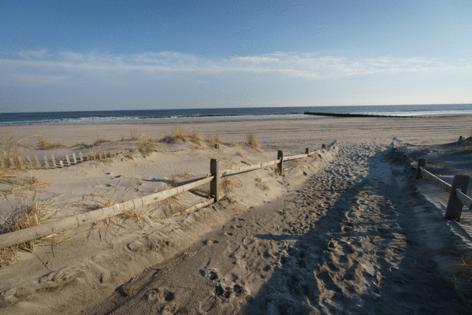Bones that washed up on New Jersey beaches are identified as the captain of a 19th-century ship traveling to Philly
Published in News & Features
PHILADELPHIA — Skeletal remains that washed up on several South Jersey beaches starting in 1995 have been identified as a 19th-century ship captain who was commanding a schooner bound for Philadelphia at the time of his death, bringing an end to a three-decade mystery.
The remains were those of 29-year-old Henry Goodsell, who died in the wreck of a ship dubbed the “Oriental” off the coast of Brigantine in 1844, the Ramapo College Investigative Genetic Genealogy Center said in a statement. The schooner was transporting about 60 tons of marble to be used in the construction of Girard College when it went down, according to reports from the time.
Goodsell’s remains began washing ashore in 1995, when his skull was discovered on a beach in Longport, Atlantic County. More bones were discovered in Margate in 1999, and additional remains washed up in Ocean City, Cape May County, in 2013. Due to their wide dispersal, the remains came to be known as “Scattered Man John Doe,” a nickname that stuck for years as investigators failed to determine their owner’s identity.
But in 2023, the New Jersey State Police partnered with Ramapo College’s genealogy center in Mahwah to crack the case. The center sent a sample to a forensics lab, which later uploaded its results to genealogy databases.
As part of that effort, Ramapo genealogy students found ancestral ties for the remains dating back to the 1600s in Connecticut. The students also began investigating reported shipwrecks off the New Jersey coast, and found the wreck of the Oriental referenced in two newspaper reports from the time — one in the York Democratic Press, and another in the Boston Daily Bee.
According to those reports, the Oriental began its journey from Connecticut to Philadelphia in December 1844. Onboard were five crew members, along with the marble slated for Girard College, when the ship began to leak. It sank about a mile from the shoreline off the coast of Brigantine Shoal, killing everyone aboard.
The ship sank on Dec. 4, 1844, according to records maintained by the New Jersey Maritime Museum. Only one crew member’s body, a man named John Keith, was discovered following the wreck, the Boston Daily Bee reported at the time.
It was not clear how the wreck impacted Girard College, which was under construction when the Oriental went down. The school opened in 1848, and by June 1845 — six months after the wreck — work on the facility was “proceeding with a considerable degree of activity,” according to a Public Ledger report from the time.
Following the students’ discoveries, New Jersey police in March collected a genetic sample from one of Goodsell’s great-great grandchildren. Authorities confirmed Goodsell’s identity in early April, bringing an end to the mystery, which is considered to be among the oldest cold cases solved using investigative genetic genealogy, Ramapo College said.
“Identifying human remains is one of the most solemn and challenging responsibilities law enforcement is charged with,” said Patrick Snyder, chief of county detectives at the Atlantic County Prosecutor’s Office.
“Law enforcement works hard knowing that behind every case is a promise: that no one will be forgotten, and that we will pursue the truth until families have the answers they deserve.”
The students’ work, Cape May County Prosecutor Jeffrey Sutherland said, not only identified Goodsell, but revealed a piece of local history, and showed how genetic genealogy techniques can be used in solving difficult cases.
The work of the college and New Jersey State Police “has demonstrated the power and accuracy of this new technology combined with classic detective work in solving complex cold cases that will bring offenders to justice and provide closure to victim’s families,” he said.
Goodsell’s case, however, is not the first that Ramapo College’s genealogy center has been a part of. The center, in fact, has consulted on some 92 cases, including identifying the partial remains of Maria Quinones Garcia, which were discovered in Pohatcong Township, N.J., in 2017, three years after she went missing from Allentown.
______
©2025 The Philadelphia Inquirer. Visit inquirer.com. Distributed by Tribune Content Agency, LLC.







Comments